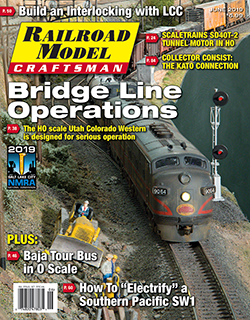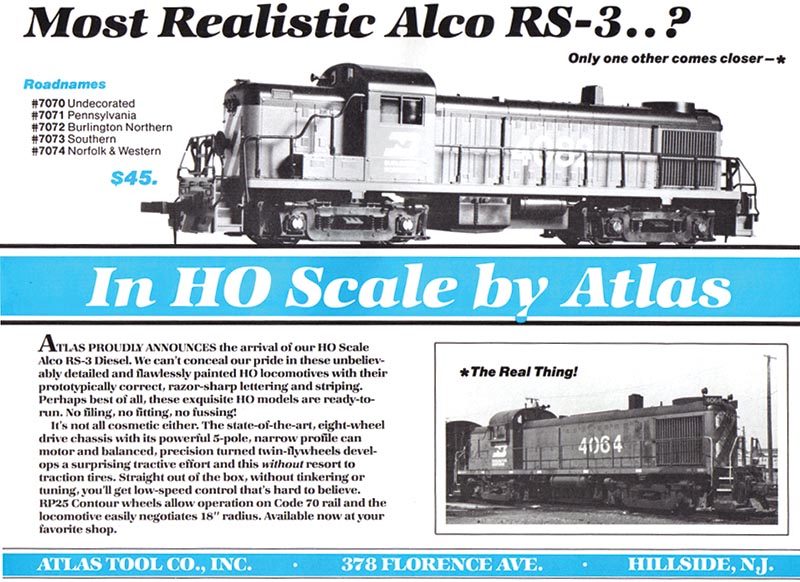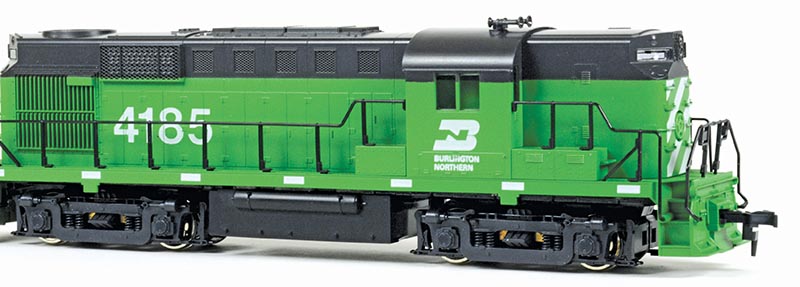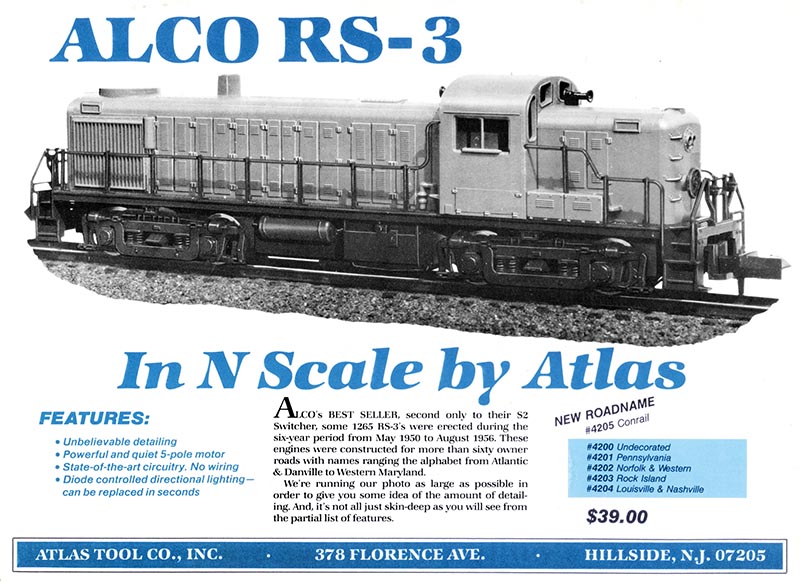 By Tony Cook/photos by the author
By Tony Cook/photos by the author
Our model railroad hobby has a rich history of product innovations that have seemingly been lost to history. Many of us also have shared memories of our first scale model, or maybe are curious about the development and history of some of the legendary companies that have graced the catalogs over the years. I hope you’ll welcome the quarterly return of “Collector Consist” to the pages of RMC. —O.M.V.
When we were discussing possible topics to present in this column, editor Otto Vondrak told me he’d always thought highly of the Atlas diesel locomotive models produced by Kato in the 1980s. He is not alone in his opinion of these well-remembered releases, as many modelers share this positive take on these pioneering scale diesel models.
Atlas has been a player in the hobby since their founding by Stephan Schaffan, Sr., in 1924. The company, originally Atlas Tool Company, became the lifelong pursuit of Stephan Schaffan, Jr., in the early 1930s. Most famously, Atlas goes down in hobby history for its track products and related releases. The full line of Atlas models that we all know and appreciate today is something that began in the 1960s with a new line of structure kits for HO scale. Many of these are today considered classics, such as the Hillside Lumber Co., the Passenger Depot, and Signal Tower. The move into locomotives and rolling stock began in the late 1960s in N scale, followed in the early 1970s with some O scale offerings. Atlas sourced its 1:160 line from a variety of manufacturers, including Mehano, Rivarossi, and Roco. In the early 1970s, Roco returned once again to supply the limited O scale offerings. In late 1974, Atlas expanded into the world of HO scale locomotives with the arrival of an Electro-Motive Division (EMD) SD24. Produced by Roco of Austria, the SD24 was soon joined by several siblings, all based on EMD prototypes – the SD35, GP38, GP40, and FP7. Priced at $25 each, you’d expect these smooth-running releases with good detailing and scale-width hoods would have been big sellers. However, the typical Athearn “Blue Box” locomotive retailed for upwards of $10 less and some saw the $25 price tag “too expensive.” Following the quick succession of introductions during 1975 and into early 1977, no more new Roco-made diesels came out for Atlas’ HO line.

In 1984, Atlas imported a new production of their HO scale GP38 and GP40 diesels. Once again sourced from Roco in Austria, the 1980s editions featured directional headlights for the first time and retailed for $45 each. What followed the next year took this line to a new level that raised the bar on consumer expectations for all future HO scale diesel models. In 1985, Atlas began to source new locomotive releases from Kato of Japan.
Founded in 1957 by Yuji Kato, Tokyo-based Kato Precision Railroad Models first entered the market producing trains based on Japanese prototypes, such as the Shinkansen bullet train. In 1986, subsidiary Kato USA was established to design and market models of American prototypes. Besides developing products for Atlas and others, Kato USA began releasing unique models under their own branding as well.
Before the HO line received its first Kato-made diesel, Atlas introduced an Alco RS-3 in N scale in 1983 made by Kato. As it would do for HO, this N-scale RS-3 boasted excellent scale dimensions and an extremely smooth-running and nearly silent drive mechanism. In 1985, Atlas introduced their Alco RS-3 for HO scale with a full-page ad asking, “Most Realistic Alco RS-3?” As the first of a series of diesel models produced for Atlas by Kato in Japan, the powered RS-3 came fully assembled and retailed for $45. The general design followed the approach of the earlier Roco diesels, but Kato’s smooth-running mechanisms upped the ante; and the refined details on the plastic shell aimed a bit higher than previous offerings.
Atlas’ RS-3 depicted by this HO-scale plastic model is an early production Alco prototype matching output from the unit’s mid-1950 introduction through approximately 1953. The exhaust stack (sitting perpendicular to or crosswise on the long hood) employed on the original tooling presented the later production phase (1954-1956) prototype with water-cooled turbocharger. After filling a long-time void in the hobby with a high quality HO RS-3, Atlas had instant competition from Stewart Hobbies, which was followed not long after by Roundhouse with another RS-3. Stewart’s RS-3 was a flat-stock plastic kit, while Roundhouse released a single-piece plastic shell. Stewart’s tooling was comparable to Kato’s work with tread pattern on walkways and both included molded-on grab irons. Though Stewart added a Phase II RS-3 with months of its first RS-3 release, the flat-stock kit was likely an impediment in comparison to the fully assembled Atlas-Kato model. Both companies relied on Athearn-made drives and truck sideframes originally. The Kato drive was and remains a super performer and topped the competition easily and helped establish this run of 1980s Atlas offerings.

As was the situation in the 1970s, the releases produced by Kato for Atlas came out in rapid succession. Joining the RS-3 in 1985, Atlas introduced additional HO locomotives based on Alcos – an RS-11 and a RSD-4/5. For 1986, the trend continued with an RSD-12, C-424, and C-425. An Alco RS-1 debuted the following year, and the Kato efforts concluded in 1990 with the only EMD in the bunch, a GP7.
While Atlas’ RS-3 went down in history as a “best ever” release, there was a misstep among the Alco offerings. Collectors of this group of 1980s offerings will point out the RSD-12 of 1986 as a model to obtain. Following the tooling of the RS-11 and RSD-4/5, those units were essentially combined to make the RSD-12 release. While those components offer the basics, they are not entirely accurate. Employing the RS-11 hood presents shortcomings in the accuracy of select details, such as the location of air filters. The RSD-4/5’s trucks are very close, but their brake cylinders on the upper corners are not exact for what Alco put on its prototype RSD-12. This model enjoyed only a single production and never returned.

There are a couple of other Alco switchers that I didn’t list that Atlas delivered in the 1980s. In 1986, Atlas introduced an S-2, and the similar S-4 followed in 1990. What I discovered in my research into this line was that Roco, and not Kato, was supposed to be the supplier for the 1980s Atlas diesels. Those re-issued GP38 and GP40 models of 1984 might have been followed by more Roco diesels, very likely the same prototypes produced by Kato for Atlas. For a variety of reasons, sourcing moved from Europe to Japan and Kato fulfilled the production on the majority of the 1980s Atlas diesels. Among the events of the early 1980s that possibly played into all this was the passing of Stephan Schaffan, Jr., in the spring of 1983.
Around 2000, Atlas introduced its “Classics” series and most of these Alco diesels, along with the lone EMD GP7, returned to market with revised versions produced in China. These trend-setting locomotives remain in the catalog today, and sport separate grab irons and other refinements that include contemporary Digital Command Control and sound options. For many modelers looking to obtain Alco power, the Atlas models are their first choice for smooth operation and fidelity to the prototype. Older releases can be found on the secondary market for reasonable prices, and are great candidates for painting and detailing projects.
TONY COOK is editor of White River Productions’ Model Railroad News magazine, and co-editor of HO Collector quarterly. Watch for the Alco-themed 3rd Quarter 2019 edition of HO Collector due later this summer. You’ll find an “Alco Timeline” feature presenting all HO-scale plastic Alco diesels produced since the 1950s.



